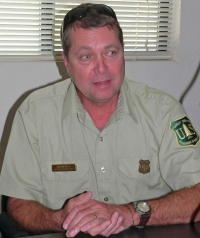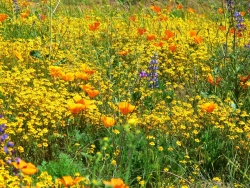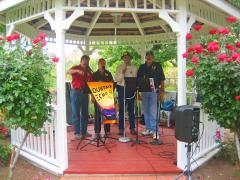Cleveland National Forest Director William Metz met with Powerlink opponents Tuesday; said presentation of alternative route provides “opportunities”

By Miriam Raftery

April 7, 2010 (Alpine) – Thus far, SDG&E has gained approval for its proposed high-voltage Sunrise Powerlink project from the California Public Utilities Commission and the Bureau of Land Management. But one major hurdle remains. Much of the proposed southern route runs through U.S. Forest Service lands--and requires approval of Cleveland National Forest director William Metz.
Yesterday, Metz met with citizens and leaders of groups representing over 79,000 local residents opposed to the controversial project. "I am keeping an open mind,” he told them,“and I'm still trying to figure out if it’s the right thing to do or not.”
Metz added that Forest Service officials have spent the past year in discussions with SDG&E, then said he is studying resource surveys and weighing evidence—including an intriguing presentation made by residents at yesterday’s meeting.
Laura Cyphert, co-founder of the East County Communication Action Coalition, said the Powerlink would have “impacts on the forest that will be forever.” She said SDG&E opted not to route Powerlink through Anza Borrego Desert State Park or tribal lands because of opposition, and urged the Forest Service to resist SDG&E’s proposal as well.
 “We’re really worried about burning alive,” said Robie Faulkner, a Star Valley Road resident (photo, right) who said his family narrowly escaped twice from fires, which spared their home only because the winds shifted. “If they put those towers in,"he predicted, "we can’t get out.”
“We’re really worried about burning alive,” said Robie Faulkner, a Star Valley Road resident (photo, right) who said his family narrowly escaped twice from fires, which spared their home only because the winds shifted. “If they put those towers in,"he predicted, "we can’t get out.”
Metz seemed most intrigued by a video presentation made by Katheryn Rhodes, a civil engineer who made a compelling case that Powerlink could be co-located alongside the existing Southwest Powerlink at lower cost and with far less negative impacts on the environment and communities in East County.
 “Why choose a line that is 50% longer? Why not in a straight line?” she asked, later noting that SDG&E has a clear profit motive to build a longer and more convoluted line, since the CPUC has agreed to allow Sempra Energy, parent company of SDG&E, an 11.1% profit on its planned $10.6 billion expenditure of capital projects, which will be passed onto ratepayers. “The more Sempra spends, the more Sempra can collect in guaranteed profits,” she explained in a later e-mail.
“Why choose a line that is 50% longer? Why not in a straight line?” she asked, later noting that SDG&E has a clear profit motive to build a longer and more convoluted line, since the CPUC has agreed to allow Sempra Energy, parent company of SDG&E, an 11.1% profit on its planned $10.6 billion expenditure of capital projects, which will be passed onto ratepayers. “The more Sempra spends, the more Sempra can collect in guaranteed profits,” she explained in a later e-mail.
According to Rhodes’ presentation, two reasons given by SDG&E for not considering co-location in a straight line along the border with Mexico are that a section of Campo Indian land bars the way, and because the border route has had several fires, indicating a higher risk. View documents here: http://docs.google.com/fileview?id=0B_fHftxFXFhyNmVkZDQ2NmItMDc4NC00YzQy...
http://docs.google.com/fileview?id=0B_fHftxFXFhyNTdmMjVjMDQtY2Q5ZS00NTlh...
But Rhodes noted the section of land in question was purchased by the Campo Indians in 2007, meaning it is not part of the tribal reservation and thus could be taken by eminent domain if the tribe refuses to sell it to Sempra.
 As for the fire safety argument, Rhodes said she has seen fires in the area where Sempra claimed none have occurred. She then spoke with Cal-Fire and learned that the map that Sempra used to make its case with officials does not show any data on fires from the Bureau of Land Management, which does not track fires on any BLM lands. She added that Cal-Fire confirmed Sempra officials “have never met with Cal-Fire” and that claims that the forest lands route would increase reliability are inaccurate. She also disputed a Sempra claim that there is no room to expand the San Miguel or Bonita substation. Showing a map with abundant space around one of the facilities, she said bluntly, “That is a lie.”
As for the fire safety argument, Rhodes said she has seen fires in the area where Sempra claimed none have occurred. She then spoke with Cal-Fire and learned that the map that Sempra used to make its case with officials does not show any data on fires from the Bureau of Land Management, which does not track fires on any BLM lands. She added that Cal-Fire confirmed Sempra officials “have never met with Cal-Fire” and that claims that the forest lands route would increase reliability are inaccurate. She also disputed a Sempra claim that there is no room to expand the San Miguel or Bonita substation. Showing a map with abundant space around one of the facilities, she said bluntly, “That is a lie.”
Co-locating the lines would minimize stress to the land and area residents, eliminating the need to go through federal forest lands, Alpine, Lakeside and other communities . “It’s easy and it’s cheap,” Rhodes concluded.
 Sempra/SDG&E was not represented at the meeting. Sempra has previously contended that located two major power lines next to each other would diminish energy security and increase the possibility that both lines could be taken off-line simultaneously in the event of a disaster. But Rhodes presented evidence to suggest that even with the route currently proposed by Sempra, both lines could go down in the event of a major fire.
Sempra/SDG&E was not represented at the meeting. Sempra has previously contended that located two major power lines next to each other would diminish energy security and increase the possibility that both lines could be taken off-line simultaneously in the event of a disaster. But Rhodes presented evidence to suggest that even with the route currently proposed by Sempra, both lines could go down in the event of a major fire.
Metz praised Rhodes on her presentation and pledged to put her in touch with a team leader for further discussion. After the meeting, Rhodes followed up with an e-mail requesting a multi-agency meeting with officials from the Forest Service, Cal-Fire, and the California Public Utilities Commission to discuss the fire maps.
Other area residents voiced a variety of other concerns.
 A woman from Carveacre said she believes towers would spoil the pristine forest as a recreational area. “We are in the forest five days a week,” she said, adding that her family enjoys running and walking in the forest lands.
A woman from Carveacre said she believes towers would spoil the pristine forest as a recreational area. “We are in the forest five days a week,” she said, adding that her family enjoys running and walking in the forest lands.
East County Magazine asked Metz if the Forest Service has asked for evidence that SDG&E has conducted adequate seismic studies on the southern route, taking into account forecasts by some experts who predict a future earthquake of a magnitude up to 7.5 in the area. “Absolutely we have had no discussions on that,” said Metz, who said Forest Service officials assume SDG&E knows the structural integrity of the towers. “I don’t think I’ve ever heard of a tower coming down,” he added.
One area resident who has existing towers on his property said nothing will grow around them as a result of herbicides sprayed by SDG&E. He added that proximity to high voltage lines has made it “almost impossible for me to get fire insurance.” Now, he observed, “They’ve threatened me with eminent domain. I said, `Bring it on.’
Another landowner voiced concerns about potential blasting, which she feared could damage water supplies.
Metz said he didn’t think blasting would be severe enough to cause such damage. Clearing around towers would be “as minimal as we can possibly get them” he added.
But Cyphert noted that a national energy was declared through the forest last year. She asked if that meant clearance could be widened later to 1,000 feet.
“I would say that’s accurate,” said Metz, adding that future power lines or a pipeline could be brought through the area in the future.
Owen Martin, also with the USFS, acknowledged that fire is a “frequent visitor” to the area. “Laguna country has not burned in 30 years,” he said. “There will be another large fire whether or not there is a Sunrise Powerlink. It will be large and it will be catastrophic.” He said the Forest Service is actively engaged in fuel reduction around communities to lessen fire danger.
 Metz agreed that fire is the overriding concern. He revealed that almost three percent of fires in national forests are caused by power lines.“In the Cleveland National Forest, power line fires resulted in 30% of the burned acreage,” he added, but said those fires were caused by smaller lines on standard poles, not the high voltage lines that would be strung between sturdier towers if Powerlink is built.
Metz agreed that fire is the overriding concern. He revealed that almost three percent of fires in national forests are caused by power lines.“In the Cleveland National Forest, power line fires resulted in 30% of the burned acreage,” he added, but said those fires were caused by smaller lines on standard poles, not the high voltage lines that would be strung between sturdier towers if Powerlink is built.
He clarified that his decision must be made based on impacts to the forest such as sustaining ecosystems; he has no authority to make determinations based on whether the line will carry renewable energy or other factors unrelated to the forest.
He also indicated that besides recreational usage and ecosystem impacts, forestry officials must also consider the potential “greater good” of energy corridors to benefit society overall.
He thanked the residents for a “great discussion” and said he anticipates the decision will be made soon, but declined to state a specific date. With SDG&E moving forward on eminent domain of up to 80 East County properties to begin construction this summer, however, residents hope a timely decision by the Forest Service to reject Sempra’s proposal could halt the project or force a major route change in time to save their homes.
 Metz faces enormous pressures from from Sempra and its backers pushing for the project, and from concerned residents opposed to it. A Powerlink Protest Song by Mountain Echo even singles out Metz by name with lyrics that read,
Metz faces enormous pressures from from Sempra and its backers pushing for the project, and from concerned residents opposed to it. A Powerlink Protest Song by Mountain Echo even singles out Metz by name with lyrics that read,
So please do what you need to do,
We know you love the forest, too;
You can stop them if you want to, William Metz.
Former Sempra Energy lobbyist David Hayes was recently appointed by President Barack Obama to serve as deputy director at the Department of the Interior. Although the Forest Service is under the U.S. Department of Agriculture, not the Interior Department, Metz suggested that the Obama adminsitration may be pushing for the project as well. Asked by one resident what more concerned citizens could do and whether "more letters to Obama" should be written, Metz replied, "That's one way."
“I am maintaining my objectivity,” Metz assured the concerned citizens of East County. “This is very important. I take this responsibility very seriously,” he concluded, “and I will make the best-informed decision that I can.”











Recent comments